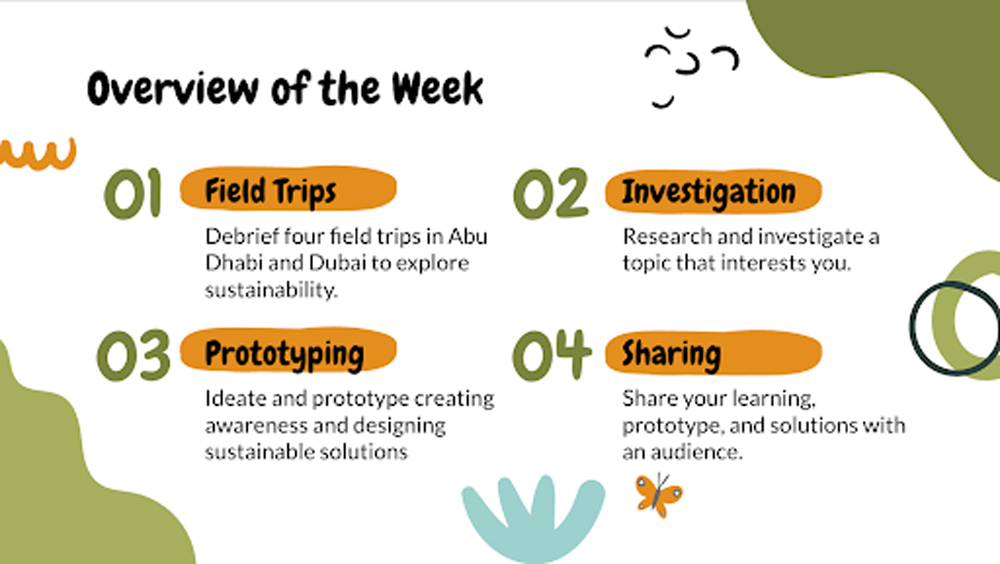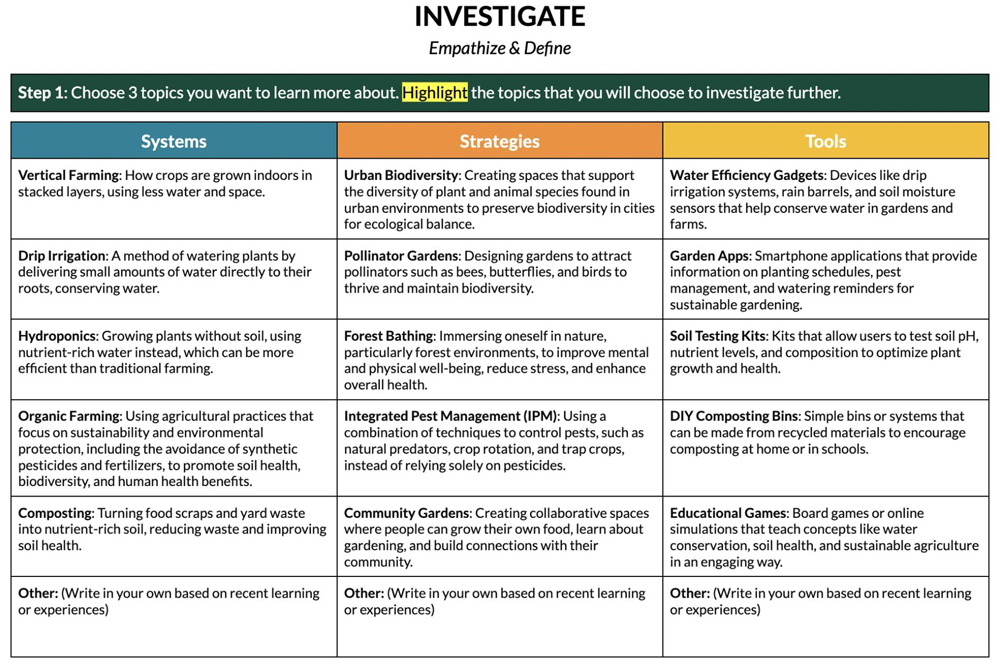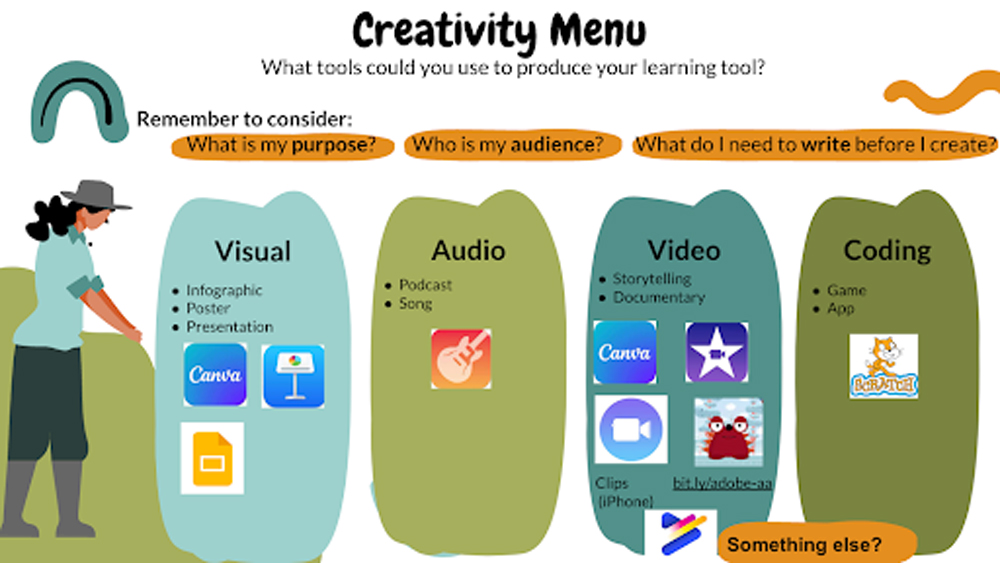
If you are a service learning or global citizenship educator who regularly incorporates action, sustainability, and changeseeking/chagemaking into your curriculum, chances are you have noticed connections and intersections between your content area and other content areas. Perhaps you have even considered teaming up with colleagues to create an interdisciplinary, experiential experience for students.
Grade 7 teachers at the American Community School of Abu Dhabi (ACS-Abu Dhabi) accomplished a high level of collaboration when they designed and ran a “Quest for Green” week-long program that pulled together multiple strands of the curriculum and sparked meaningful investigation, community engagement, and action.
Creating an interdisciplinary and experiential learning experience that features service, sustainability, and action involves a multifaceted approach. Below are some key things to consider for educators looking to implement such a program, along with examples of how the ACS-Abu Dhabi “Quest for Green” experience exemplifies some of these approaches.
1. Start with a Vision
Define clear objectives that capture the essence of service, sustainability, and action for your interdisciplinary learning experience. Ensure your objectives are aligned with your school's broader educational goals and values.
What do you hope your students will achieve or learn?
Why will an interdisciplinary and/or experiential approach deepen engagement and learning?
The ACS-Abu Dhabi experience started with Jenny Derby, an innovation coach. She had been tasked with growing interdisciplinary approaches at the school and she partnered with Mel Pubil, the all-school service learning coordinator, to support the Grade 7 team. A Grade 7 science teacher had reached out to Mel about adding service to a unit, and this provided a natural entry point for an interdisciplinary approach that served as the foundation for the vision for “Quest for Green.” As ACS-Abu Dhabi has just moved to a new campus, ideating about green spaces and gardens at the school connected perfectly with the science unit’s emphasis on sustainable agriculture. As math, social studies, and language arts teachers partnered with science, they were all able to link their units to themes of sustainability, green spaces, and food.

Overview of the planning for the week. (Photo source: ACS-Abu Dhabi)
2. Engage in Collaborative Planning
Involve teachers from different disciplines in the planning process to ensure that the program is genuinely interdisciplinary. This collaboration can lead to the integration of diverse perspectives and areas of expertise, enriching the learning experience for students.
With “Quest for Green,” all core teachers were involved in collaborating and teaching through the interdisciplinary blocks and experiences. The team was supported by Jenny and Mel in their coaching roles (they did a lot of the planning and prep for the week), and middle school leaders were very supportive in setting up a flexible schedule for this experiential learning week.
3. Connect with the Community
Identify local or global community partners who can provide opportunities for service and action. These partners can offer real-world contexts for students to apply their learning and make a tangible difference. Consider non-governmental organizations (NGOs), environmental organizations, local businesses, or community groups.
To kick off “Quest for Green,” all Grade 7 students participated in a field trip with local partners connected to sustainable agriculture or gardening. Trips included the organic Mazaraa Farm in Abu Dhabi, Emirates Palace Beekeeping, the Expo Terra Pavilion in Dubai (where students engaged in a water scarcity workshop), and a tour of the gardens and apiary at the American School of Dubai. After the students went on the field trips and synthesized what they had learned about green spaces, they continued to connect with community members within the walls of ACS-Abu Dhabi. Elementary teachers and students became partners in this experience, along with a variety of adults who participated in interviews and ideation sessions.
4. Incorporate Experiential Learning Opportunities
Design activities that allow students to learn through direct experience. This could include field trips, service projects, sustainability initiatives, or hands-on workshops. Experiential learning helps students connect theoretical knowledge with practical application.
The field trips described above were an integral part of the ACS-Abu Dhabi “Quest for Green” experience and were designed to spark inquiry for the rest of the week. As well, as students prototyped ideas for green spaces on campus, they used the maker space, and worked with younger learners in experiential, creative ways.
 Examples of experiential, hands-on learning on campus during “Quest for Green.” (Photo source: ACS-Abu Dhabi)
Examples of experiential, hands-on learning on campus during “Quest for Green.” (Photo source: ACS-Abu Dhabi) 5. Focus on Sustainability
Embedding sustainability into the curriculum across subjects can foster interdisciplinary knowledge and awareness. Discuss environmental issues in science classes, explore the social dimensions of sustainability in humanities, and encourage creative expressions of sustainability themes in arts education. Helping students make connections across the curriculum supports critical and creative thinking, and shows students the relevance and applicability of content knowledge.
Sustainability was the foundation of “Quest for Green” at ACS-Abu Dhabi. Because the core of the challenge was for students to investigate solutions and approaches for creating green spaces on the new campus, sustainability and ecology were at the forefront of experiential learning throughout the week. Students learned specifically about drip irrigation, composting, and forest bathing (students loved learning about forest bathing!) along with a variety of other sustainability themes.

6. Foster Critical Thinking and Reflection
Encourage students to critically evaluate their learning experiences and the impact of their actions. Regular reflection sessions can help students make connections between their experiences, the curriculum, and the broader world.
Mel and Jenny used both the service learning cycle and the design thinking cycle with students in “Quest for Green.” The two cycles are very similar and combining them allowed students to embrace the “how might we?” nature of design thinking alongside taking action. Students could choose from two tracks as they investigated green spaces on campus. They were able to prototype a solution or an idea, or they were able to design a tool to teach others about sustainability and the value of green spaces. This choice helped foster critical thinking and engagement as students synthesized their research and learning, and there was ample opportunity for students to reflect and receive feedback throughout the week.
7. Leverage Technology
Utilize digital tools and platforms to enhance learning and facilitate action. This could involve using online forums for collaboration, leveraging social media for awareness campaigns, or employing digital mapping tools for environmental projects.
Grade 7 students used several tech tools and apps during “Quest for Green,” particularly with research and prototyping. They also used digital tools and platforms to take action by teaching younger learners at ACS-Abu Dhabi about sustainability in green spaces. The entire experience was built on resources available in Google classroom such as shared documents, spreadsheets, and slides.

8. Build Leadership and Teamwork Skills
Design projects that require students to work in teams and take on leadership roles. These experiences can develop essential skills such as communication, problem-solving, and project management.
“Quest for Green” students were able to choose to work alone or with a group, and most chose to work with a group. They had agency in deciding the size and make-up of the groups, and this allowed all students to take on various leadership roles throughout the experience.
9. Assess Progress and Impact
Develop methods to assess both the learning outcomes for students and the impact of their projects on the community or environment. This could involve portfolios, presentations, feedback from community partners, or impact assessments.
Grade 7 students who engaged with younger learners in the ACS-Abu Dhabi community were offered feedback from classroom teachers. Students received plentiful peer feedback throughout the week as well. In fact, at the end of “Quest for Green,” most students were at the stage of receiving peer feedback on their prototypes, and this provided excellent closure for the week. Many students are continuing to work on their projects, and there will be a showcase on Earth Day (22 April) to share stories with the entire community of what students learned, the actions they took, and the impact of those actions.
10. Cultivate a Culture of Service and Action
Beyond individual projects or programs, aim to foster a school-wide culture that values service, sustainability, and action. Celebrate achievements, share stories of impact, and encourage ongoing engagement with these themes.
Many Grade 7 students are excited about the tools or prototypes they created and designed and many students are continuing to work on their plans even though the official “Quest for Green” week is over. The engaging nature of this learning experience has created an intrinsic desire in students to investigate and apply their knowledge, and to listen deeply to community members and stakeholders. As a consequence, many students will now continue their work after school and in club settings, and this sets a lovely precedent for all learners - that personal passions sparked by curriculum and content can be meaningful and result in ongoing learning. When students get to share their success stories at the Earth Day showcase, these stories will fuel even more awareness of sustainability and service as action, thus continuing to shift the narrative about changeseeking and changemaking at ACS-Abu Dhabi.
Jenny and Mel ran a Futures Thinking protocol with teachers after “Quest for Green” and realized their approach to planning could serve as a model for any major initiative in teaching and learning. They are thinking about how to extend this experience to create stronger frameworks for leading interdisciplinary experiences and to invite teachers into leadership roles as well.
Hear more about this at about the 24-minute mark in the video shared below.
11. Ensure Inclusivity
Make sure the program is accessible and relevant to all students, regardless of their background. Adapt projects and activities to meet different needs and interests, ensuring that every student can participate meaningfully.
Student voice, choice, and agency can go a long way in making learning experiences inclusive and equitable. In “Quest for Green,” this was certainly the case, and students felt equipped and empowered to participate and learn. The deep engagement demonstrated by students is excellent evidence of the inclusivity of the experience and how supported students felt in their investigation and action. One student, who designed a drip irrigation system and solar panel, is excited to continue building sustainable solutions (you’ll hear her story about 18 1/2 minutes into the video). The cross-divisional partnerships between kindergarten and lower elementary with Grade 7 in this experience also fostered strong community building, listening, and inclusion.
At 20.5 minutes in the video shared below, hear Mel talk about her conversation with a student struggling to identify something they were interested in investigating, and how personalized coaching helped that student discover something they were keen to research and learn more about.
A Collaborative Approach for Interdisciplinary Learning
By following these suggestions, you can design interdisciplinary and experiential learning experiences that not only enrich students' academic knowledge but also prepare them to be active, informed, and compassionate citizens of the world.
Listen to the interview with Mel Pubil and Jenny Derby to glean more insights into how they led “Quest for Green,” and how their example might serve as a prototype for interdisciplinary learning experiences at your school.
LeeAnne Lavender is an educational consultant, coach, and facilitator for international educators, and the Association of International Schools in Africa (AISA) Service Learning program coordinator. She specializes in storytelling, digital storytelling, service learning, and sustainability, and she loves partnering with schools and teachers to create learning experiences that have impact and lead to deep learning. She’s committed to helping educators build changemaker/change seeker cultures to equip students with skills and mindsets to engage in positive, purposeful action.
Website: https://www.leeannelavender.com/